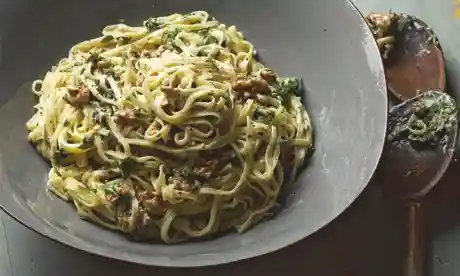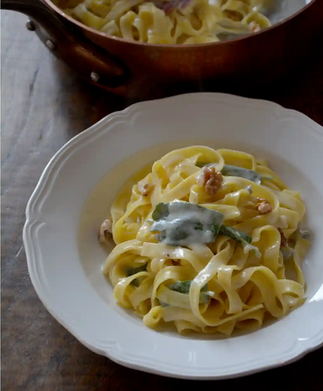When the egg meets flour - a skill
- rosemary
- Jan 2, 2024
- 5 min read
"It is in Emilia (half of the now united Emilia-Romagna region) where the everyday act of hand rolling has been elevated into an everyday art with its own set of expectations and language." Rachel Roddy

I actually began today thinking I would look at whether the Mafia (inspired by this week's piece of diary art) were involved in agriculture in Italy. Short answer - yes they are to the tune of billions of dollars in many different awful and criminal ways. Their influence is very gradually declining, but not enough. At this point I decided not to depress myself any further, but having seen an article about what were the favourite foods of all those infamous mafiosi I decided to stay in Italy and turn back to Rachel Roddy's book An A-Z of Pasta a few more pages of which I have bookmarked for further investigation. Hence tagliatelle and La sfoglia - that wonderful sheet of pasta in the picture above. So yellow, so thin.
But first a short word on mafiosi dishes. Al Capone's favourite was Spaghetti in a walnut sauce, which apparently was very simple and consisted of oil, breadcrumbs, walnuts and cheese (and spaghetti) - although current Americans seem to also add parsley, crushed red pepper and garlic. After a brief search I found two similar walnut based sauces from favourite chefs: Tagliolini with walnuts and lemon from Ottolenghi, who is, after all, half-Italian (tagliolini are narrower tagliatelle); and Rachel Roddy's Tagliatelle with Gorgonzola and walnuts. There - due deference to the Mafia done.

The name tagliatelle - and tagliolini as well, comes from the Italian verb 'tagliare' meaning to cut and legend has it that they were named for Lucrezia Borgia - "the egg-rich ribbons echoing her golden hair" says Rachel Roddy.
And tagliatelle are the traditional accompaniment to the ragù bolognese that the whole world knows and loves.
Most of Rachel Roddy's article on tagliatelle, however was dedicated to La sfoglia - hand-rolled egg pasta, and the day she visited an exponent of the art. The description is lengthy - and also her subsequent detailed instructions - so here are a couple of extracts just to give you the flavour of the skill involved:

"As much as the mesmerizing, rippling spin it is the texture of la sfoglia that strikes you. Working on a wooden board the wooden materello creates a cross-hatching of strokes that's as much fabric as pasta. Hand rolling also gives structure and energy. La sfoglia may be flat, but rolled into readiness for cutting it seems to have a life of its own."
The picture above is not of Rachel Roddy's teacher, but it easily could be.
"once she has cut the whole length, she slides the knife under the cut dough like an arm under a back and lifts so the tagliatelle hangs either side of the blade like streamers. She shakes them out before dropping them into a pile. They are also 'in piedi', standing up, she notes. It is a perfect description. Unlike the floppy ribbons of flour-dusted ribbons I am used to, Rina's arch and lift, like elbows and knees, so much so that I wonder if they might leap unassisted into the pan of water which is coming to the boil."
I was somewhat captivated but I doubt that I shall be having a go anytime soon. Well I don't have a rolling pin that long or a wooden board big enough for a start, not to mention the currently useless left hand, I suppose I could give it a go on a smaller scale. A sheet, the size of the ones in the photographs seem to use 4 eggs and 400 grams of 00 flour - or even 5 and 500. Maybe halve that?
I thought I might find an actual video and I did but not as many as I thought there might be. I also seem to have temporarily lost the ability to embed videos here. I'm suggesting two to look at if you feel like it..

The first is Making home-made sfoglia from a young man called Marcello Filibeck. This one is relatively short (3 mins.), with no commentary. You just watch. Interestingly neither he, nor the lady in my other video cut the tagliatelle directly from the sheet and lifted them up on a knife. They rolled the sheet up and sliced into it, then painstakingly, unrolled each strand before separating them out and laying them out to dry slightly before cooking. Mind you the knife that Rachel Roddy's lady used was described as 'almost a sword'. I don't have one of them.

Then there is Irma from the YouTube channel Pasta Grannies who makes tagliatelle.
This is longer - 8 1/2 minutes but if you have the time it's rather wonderful in a very low key and, I suppose, sentimental, way. For Irma is 103 years old, so it includes everything from collecting the eggs and the flour to eating the final dish of the tagliatelle with a simple sauce of prosciutto and passata. Possibly more likely than a genuine ragù that has been cooked for hours. It's a bit kitsch I suppose but she's a rather wonderful lady who still walks a kilometre a day - albeit slowly, slowly and with a walking stick.
When Rachel Roddy comes to give you her recipe she does in fact use a pasta machine - as do I. Although I don't use 00 flour. And you don't get that texture that Rachel Roddy spoke about.
"Egg pasta made by machine can be slick, pale, and insipid. Pasta stretched by hand with a matterello has far better taste, texture, and color. Furthermore, because it has tiny surface pores created by the stretching process, it absorbs more sauce. This further enhances its taste." Mark Lindsay
Would I notice though? I mean I've never made or tasted it so I just don't know. Maybe this is one of those things I should add to the list of dishes I've never cooked - along with the Beef Wellington and soufflé. Something to throw yourself into doing when you have nothing else to do. I should perhaps only be an 'authentic' perfectionist when it comes to dishes that I have made for most of my life. Irma was apparently 10 when she started making this - indeed cooking for her family. She's been making it for almost 100 years. Now there's a thought.
"I now realize that strong opinions about ragù, or any dish for that matter, are expressions of nostalgia. That repeating them is almost as comforting as eating the dish because it's another way of saying this is the way I know this is and how I hope it will stay." Rachel Roddy










Comments